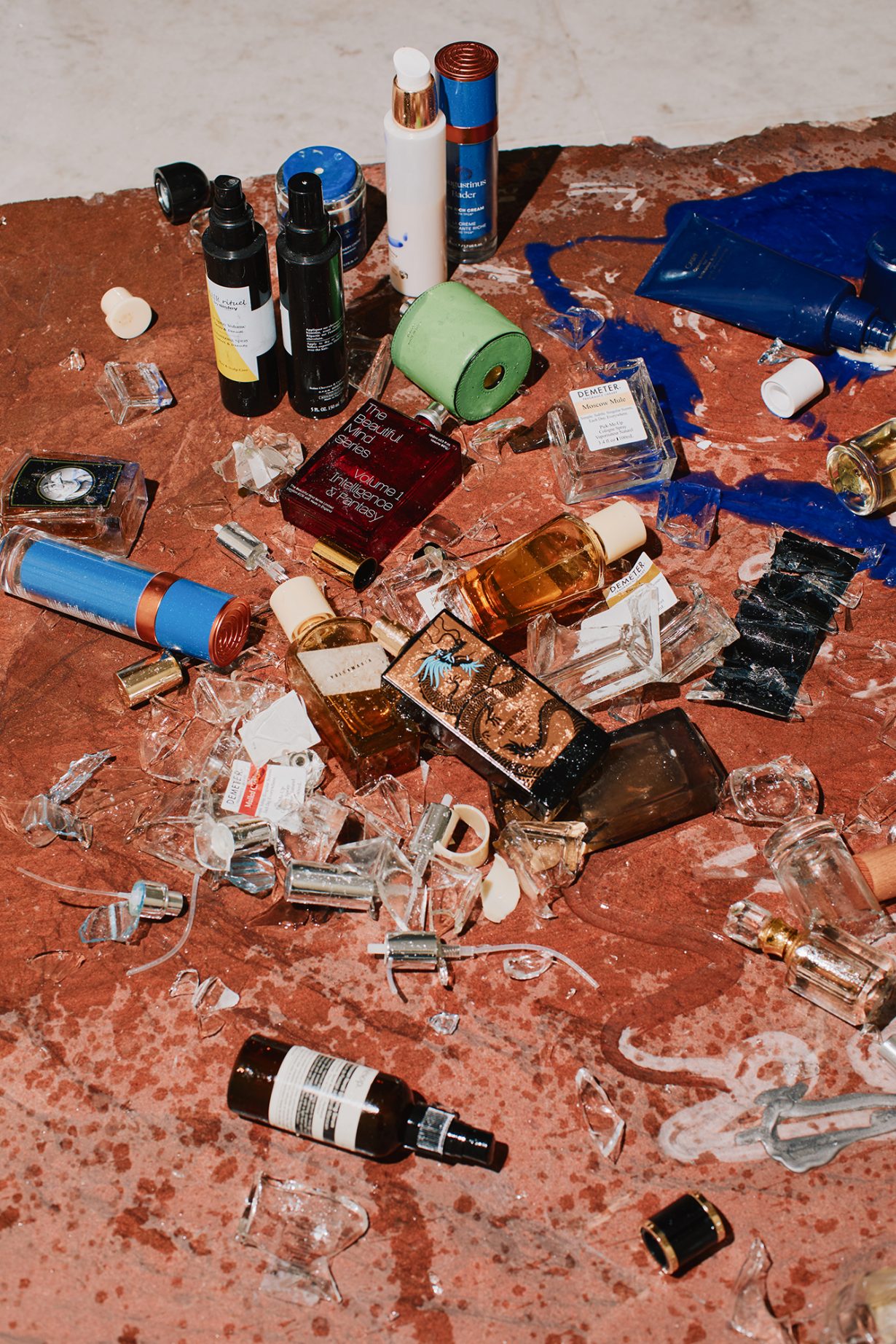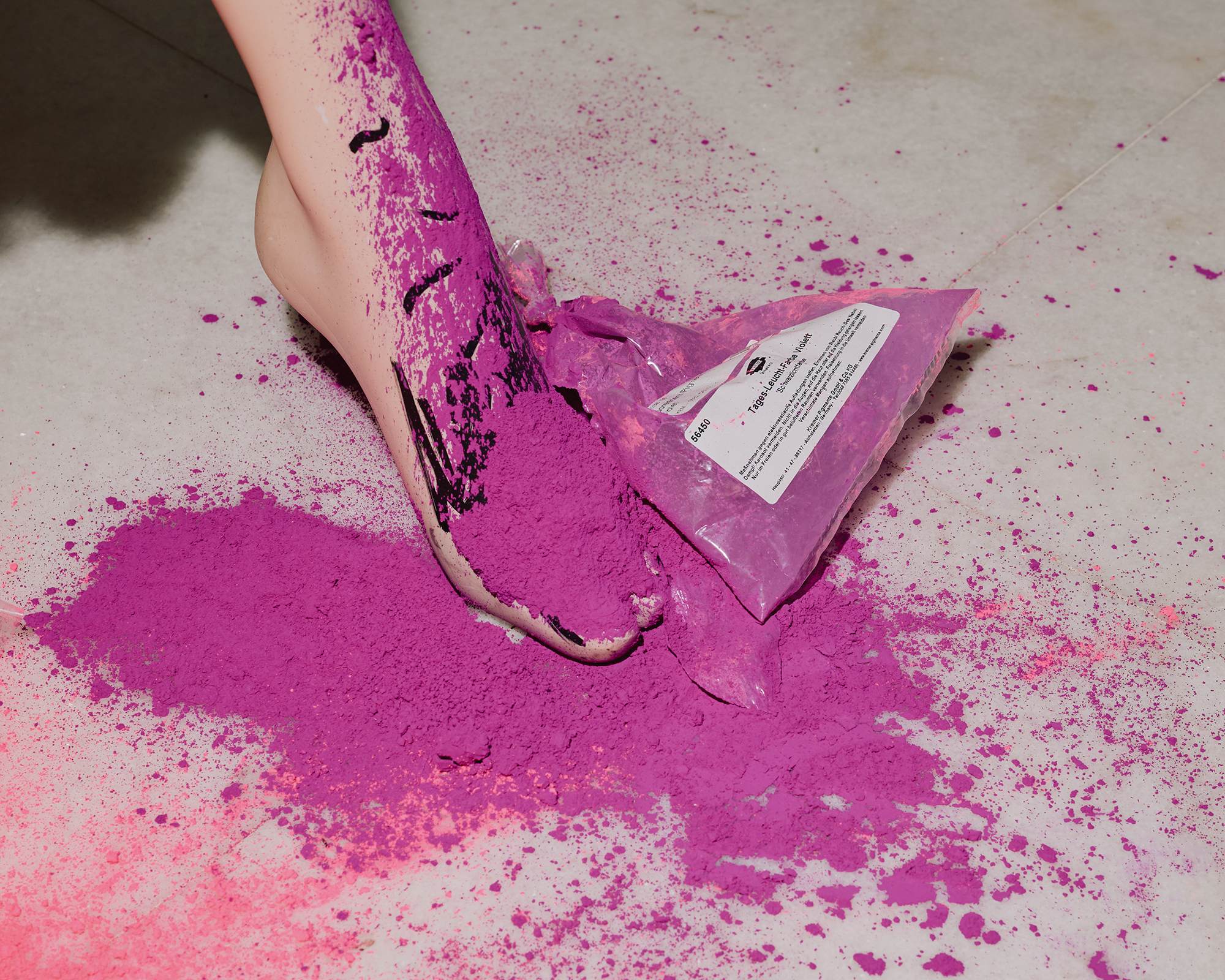In Abuse Is the Beauty of the Working Class, Bjarne Melgaard’s olfactory experiments with Bjørn Kristian Hilberg evidence an irrepressible artist at work
Since the 2013 launch of Liquid Cosmetics, a limited edition of ‘sex kits’ (poppers, lube, condoms, washcloth) made in collaboration with the American label Eckhaus Latta, Bjarne Melgaard has dallied with fashion, even launching his own clothing line in 2015. The fifty-seven-year-old Norwegian artist has worked with a number of designer labels (including, most recently, Holzweiler), and in October debuted the scent I Am Your Dog, an attempt to reproduce the smell of his pet dog, at Dover Street Market in Paris. With this first presentation at VI, VII gallery, Melgaard is flirting further with perfume.
Staged as an artworld launch for The End, Melgaard’s new fragrance line in collaboration with Bjørn Kristian Hilberg, founder of Norwegian perfumier Malbrum, Abuse Is the Beauty of the Working Class has a working scent laboratory as its centrepiece, complete with beakers full of swirling amber liquid, percolators, filling machines and bottled chemicals. Viewers encounter etched marble and limestone slabs on which rest rows of bottles containing three fragrances, Joey, Speedball and Stabfrenzy Forever, while a fourth fragrance, Crispo, is in development onsite over the course of the show. Another improvised scent, the result of smashing phials of essence on the gallery floor, fills the bijoux storefront with its suffocating floral bouquet. Projected on a nearby wall, a brand ‘trailer’ comprising animation and found footage blending money shots, nuclear tests and pop audio wheels in Melgaard’s usual abrasive preoccupations.

If his previous forays into fashion were love/hate affairs intent on subverting industry codes by intensifying their animating contradictions (as in his 2017 collection Suprem(e), a cross between independent publisher Semiotext(e) and streetwear brand Supreme), Melgaard’s approach to fragrance feels rather more reverent. Crispo, named after the late gallerist Andrew Crispo – who was implicated in the 1985 murder of a Norwegian fashion student – is a hammering of patchouli and violets. Somewhat more subdued is Joey, an homage to gay porn star Joey Stefano, a recurring figure in Melgaard’s work, who died of a drug overdose at the age of twenty-six. Here, the notes are much sweeter – what, to my untrained nose, seems like the overwhelmingly funereal scent of lilies or perhaps something like bubblegum.
While the titles suggest Melgaard’s continued attraction to the transgressive and extreme, what emerges here is something more tenuous. His olfactory experiments are framed by dozens of ink drawings depicting cartoonish figures being devoured by monsters – many doodled on legal documents from the artist’s recent highly publicised court case – and an installation featuring hyper-trendy mannequins and tombstonelike paintings characteristically strewn with ephemera, beauty products, broken perfume bottles, antipsychotic medication and stuffed animals used to treat children with schizophrenia. The perfumes are thus linked to social relations of the kind whereby an artist can, for instance, sign away the rights to their life’s work while drunk, as Melgaard did in 2020. As luxury goods, they have a whiff of desperation about them; but as expressions of the class antagonisms alluded to in the show’s title, they are more ambivalent, suggesting degrees of resistance and self-exploitation.
It’s perhaps unsurprising that Melgaard, with his visual-arts career on the brink, is diversifying his brand (he also recently launched Untitled, a trademark wine and vodka). Yet possible bankruptcy and sobriety have not blunted his work, which remains as jagged and irrepressible as ever. They have, however, amplified its pathos and, most palpably, its tragic tone. The artist’s brilliance here is to show us that the tragedy is not his alone. More than a marketing ploy, this presentation signals the ubiquity of the abuses – legal, financial, emotional – that gave it form.
Abuse Is the Beauty of the Working Class at VI, VII, Oslo, 25 October–15 December
From the January & February 2025 issue of ArtReview – get your copy.
